6.3 A Three-Stage Model of Memory

To explain events, scientists often propose explanatory models. A model is a depiction of structures and processes that caused an event to happen (Harré, 2002).
In the study of memory, the key event is that people retain information; they remember material presented previously. To explain this, psychologists propose explanatory models that depict mental structures and processes that enable people to remember material. One major model is the three-
In the three-
Sensory Memory
Preview Question
Question
 What is sensory memory and what are two types of sensory memory?
What is sensory memory and what are two types of sensory memory?
Sensory memory is memory that is based on the workings of sensory systems, that is, the psychological systems that enable you to see, hear, and feel the world (see Chapter 5). You usually think of these systems as being involved only in perception, such as the perception of light (vision) or sound (hearing). But they contribute to memory, too. Different perceptual systems (e.g., vision, hearing, touch) produce different forms of sensory memory. Let’s first look at iconic memory, which is sensory memory of visual images.
BRIEF MEMORY FOR IMAGES: ICONIC MEMORY. In psychology’s first demonstration of iconic memory, George Sperling (1960) showed participants three rows of four letters for a very brief period: 50 milliseconds (1/20th of a second). The presentation was so brief that participants had no time to think about the material; if they subsequently could recall any letters, it would be thanks to iconic memory.
218
Participants did not do very well on this task; when asked to recall the 12 letters, they reported only about one-
The capacity of sensory memory is small—
about four items. The capacity of sensory memory is large, but information fades so quickly that as participants report the initial letters (“I saw a B, and an L …”), others fade away.
Sperling devised a clever test of these possibilities. After presenting the letters, he immediately sounded a tone indicating which row of letters participants should report (Figure 6.2). In this situation, participants performed excellently; they recalled most of the indicated information. Because participants did not know which row of letters would be signaled by the tone, their excellent performance meant that most of the letters were in iconic memory when the tone sounded. Sperling thus discovered that the capacity of iconic memory is large, but the duration for which it can store information is brief.

More recently, researchers have sought the biological basis of iconic memory. You might think it would be in the eye. However, findings indicate that the biological basis of iconic memory is a network of neural systems in the brain (Saneyoshi et al., 2011).
BRIEF MEMORY FOR SOUNDS: ECHOIC MEMORY. Iconic memory is not the only type of sensory memory. People also possess echoic memory, which is sensory memory for sound.
You are probably already familiar with echoic memory from the so-
Thanks to echoic memory, we’re often able to parrot back what someone has been saying to us when we’ve been accused of not listening!
Sensory memory, then, is the first stage in getting information such as “the exam is next Tuesday” from the classroom projection screen into your mind. The second stage is short-

WHAT DO YOU KNOW?…
Question 3
3246GPg9JV/FQ6NL0FAbWPC4fz3gmrBG8lQbnrZs9d4rliRvuHflRvLRTirPUkssfZr5wpQxqbH3rix5UvAIlQNEzbK8tt3ambsfdE2cRu1NSeRzW1rn9bxy9OdYJOssYDXKR+X5sCABlilJ9RM4BppdjDUJ+VCfGg4qAPZos+GhOTjq7x7eTT8Af86S5pBeSvWtqSFzgAL90U3VnWPxh2zeyVu+bktfUQYPHjSjTk3KWd1MxvOS4TVrthAMcVF+/bVopl6KFGKqYY9pHD9jdeL0Li07KjRQbM+sk+z69XI=TRY THIS!
You have just read about some memory experiments. Now, it’s time to participate in one—![]()
219
Short-Term (Working) Memory
Preview Questions
Question
 What are short-
What are short-
Question
 Why do we forget information soon after it reaches short-
Why do we forget information soon after it reaches short-
Question
 How does working memory differ from short-
How does working memory differ from short-
The second stage in the three-
You already have some intuitive knowledge of how short-
You’d better enter the number into your cell phone soon, or you’ll forget it. The information might fade from your memory in a matter of seconds.
You can keep the information alive in memory by repeating it to yourself over and over again (“312-
555- 2368,” “312- 555- 2368,” …) until you write it down. If the number had been much longer—
for example, 312- 555- 2368- 82695873— you would never have been able to remember it.
You know intuitively, then, that (1) you possess a mental system that holds information for only a limited amount of time; (2) you can increase the retention time by repeating information to yourself; yet (3) there is a size limitation; even repetition does not work if there is too much information. This system is short-
How does information get into short-
term memory? How much information can short-
term memory hold? What causes much information in short-
term memory to quickly be forgotten? What can you do to retain information in short-
term memory?
GETTING INFORMATION INTO SHORT-
Encoding is any process that transforms information from one format to another. Recall that in sensory memory, the information format is physical stimulation (e.g., light waves that reach the eye; sound waves at the ear). The contents of short-
What information is encoded into short-
Attentional effort is a focusing of attention on something in the environment that is relevant to a goal you are trying to achieve (Sarter, Gehring, & Kozak, 2006). In everyday terms, it’s called “concentrating.” If, right now, you look up from your reading and glance around the room, many objects are in view: walls, furniture, books, an old poster, scraps of paper, candy wrappers, a roommate, and so on. You might think all this information would be overwhelming, but it isn’t. What normally happens is that you concentrate, or focus your attention, on one item at a time. If your goal is to clean your room, you might focus on the candy wrapper. If you want to redecorate, you might focus on the poster. Sometimes focusing attention requires effort; if there’s a big stack of books and papers on your desk, you might have to concentrate to notice some scattered candy wrappers. Similarly, if you’re surrounded by a variety of sounds—
220
What information are you blocking out right now to devote attentional effort to reading this?

Information receiving attentional effort is the information most likely to move from sensory memory to short-
Attention, therefore, determines which information is encoded into short-
Although attentional effort is needed often, sometimes objects simply grab your attention. For instance, if you’re on a hike and encounter a long, thin object slithering on the ground, you would notice it immediately, even if you had not been focusing attentional effort on snakes. If there is a burning smell in your home, you would notice it, even if you hadn’t been concentrating on the possibility of a fire. Or if a particularly attractive person walks by, you would notice automatically (Maner, DeWall, & Gailliot, 2008).
These examples illustrate a second type of information we encode into short-
In sum, information goes from sensory memory to short-

THE SPACE LIMITS OF SHORT-
221
When research participants heard different sounds (simple tones that varied in pitch), they couldn’t accurately remember them all if they heard more than seven.
When participants tasted substances varying in saltiness, they couldn’t keep track of more than seven different tastes.
When listening to numbers, letters, or words read aloud at a rate of one per second, they rarely could remember more than seven of them.
Miller therefore concluded that the best estimate of the capacity of short-
Not long after Miller’s work, other psychologists began to recognize that his classic estimate was an overestimate (Cowan, 2001). It turned out that, in some of the research Miller reviewed, participants likely had time, during the experiment, to transfer some information from short-
THINK ABOUT IT
When psychologists first estimated the capacity of short-
Four pieces of information may not seem like much. Yet if you try to think of more than four different things at a time, you’ll realize that it’s a lot. Try to think simultaneously about: (1) a fact about psychology (e.g., the capacity of short-
What strategies do you use to keep information running in your short-
FORGETTING INFORMATION IN SHORT-
Decay is the fading of information from memory. Like a skywriter’s message on a windy day, the contents of short-
Answering this question is difficult; a seemingly attractive research strategy is limited. To measure decay, one could (1) present information to participants, (2) wait for varying periods of time, and then (3) ask them to recall it. But there’s a problem: During the waiting period, some people might devise strategies for enhancing their memory (e.g., if the information included the three-

222
Can you think of a way to determine how rapidly information decays from short-
What proportion of material would you guess an individual forgets after 18 seconds?
Research using this method shows that information in short-
After discovering this rapid decay of information, psychologists performed more research that revealed something interesting: Some information does not decay rapidly (Neath, 1998). Information presented in the first few trials of the task decays slowly (Keppel & Underwood, 1962). In fact, on the very first trial, there is no evidence of short-
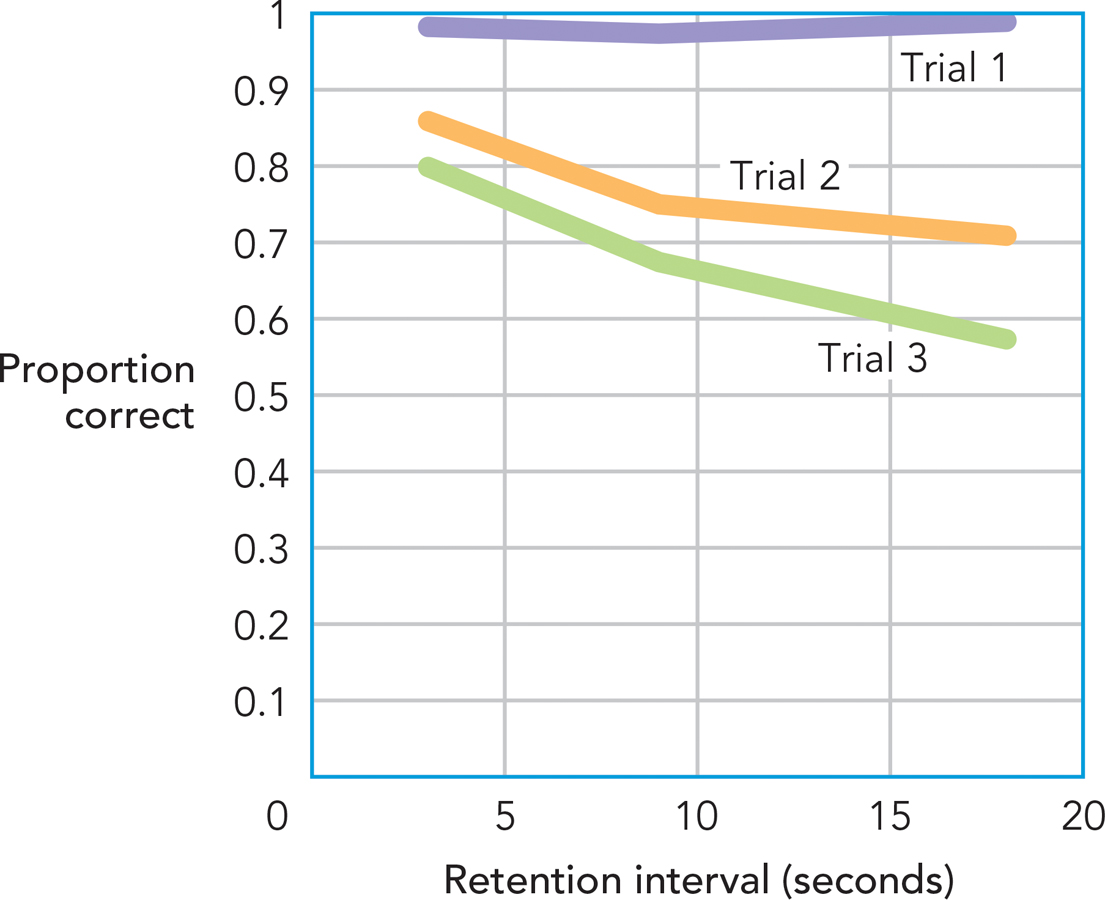
The explanation is interference. Interference is a failure to retain information in short-
As an example of these two types of interference, imagine that you sign up for a class in which 20 people are enrolled, and on the first day everyone introduces themselves in class. What would your memory of the 20 names be like? You’d probably remember the names of the first few people because when you heard them, no other names were yet stored in your short-
Results shown in Figure 6.3 demonstrate this process. On the first few trials of a task, people’s memory is excellent because there is no proactive interference. On later trials, proactive interference begins, and information decays rapidly.
This example also illustrates retroactive interference. When the last few people (i.e., the 18th, 19th, and 20th classmates) introduce themselves, you probably would remember their names. Because there are no further introductions after these people, there is no retroactive interference. You’d be more likely to forget the names of the students introduced just prior to that (e.g., the 15th, 16th, and 17th classmates to speak). Retroactive interference created by the names of the last few students interferes with memory for the names that preceded them.
Combining what you’ve learned about proactive and retroactive interference, you can make some predictions about memory performance. Whenever people try to recall a list of items, there is:
A primacy effect: Items at the beginning of the list are not affected by proactive interference (because no items came before them) and thus are remembered well.
A recency effect: Items at the very end of the list are not affected by retroactive interference (because no items came after them) and thus are remembered well.
223
Items in the middle of the list are subject to both proactive and retroactive interference. Memory for those items thus should be relatively poor.
TRY THIS!
This discussion of primacy and recency effects should remind you of something: the Try This! activity you attempted earlier in this chapter.
The activity tested your memory for a long list of words. Importantly, it didn’t report merely the overall number of words you remembered; instead, you learned the number of words you remembered from different parts of the list—
If you were like most people, you remembered relatively few words from the middle of the list. In that part of the list, memory can be impaired by both proactive and retroactive interference.
Figure 6.4 shows the results obtained when researchers run the Try This! experiment with a large group of participants and plot results for each word position. The finding is known as the serial position effect, which is people’s tendency to display better recall for items positioned at the beginning or end of a list than in the middle.
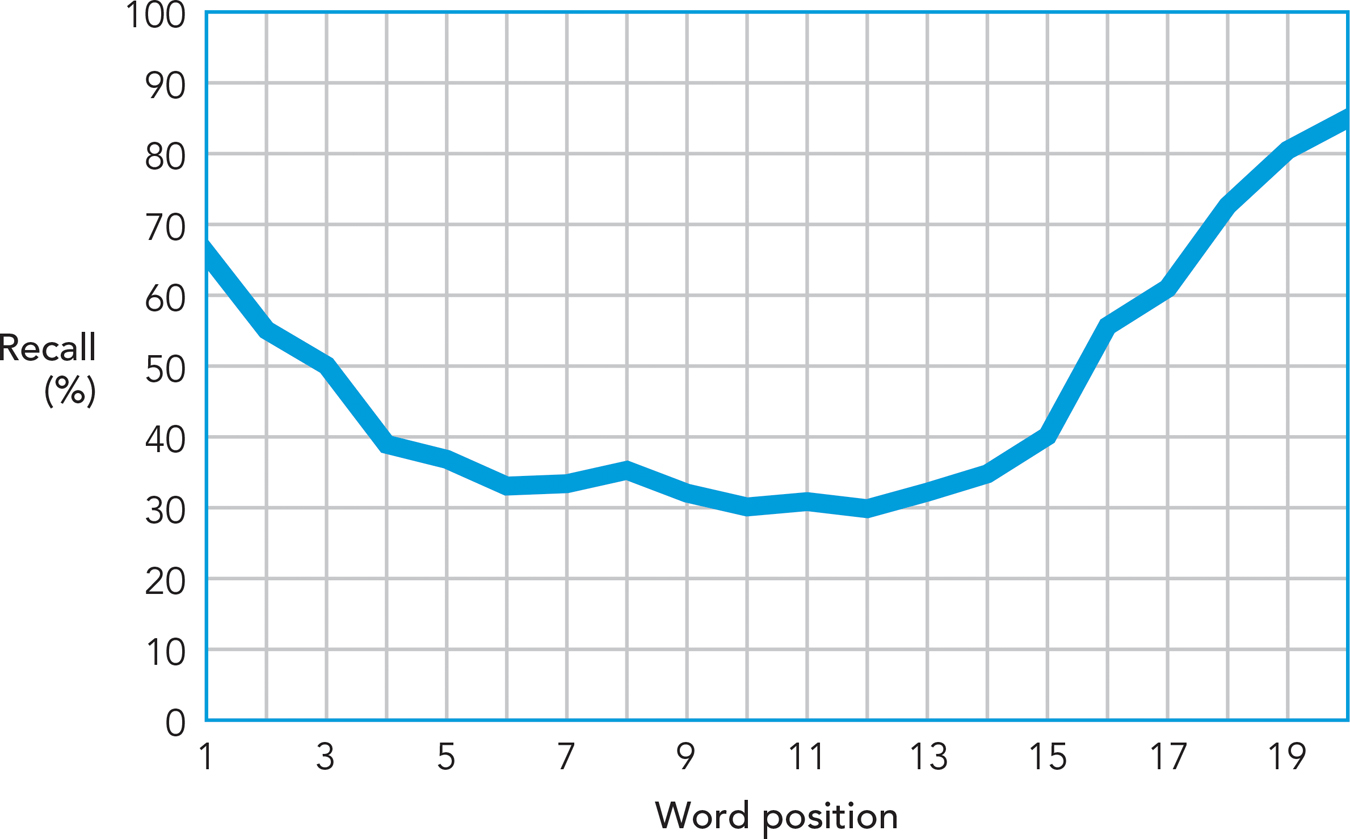
RETAINING INFORMATION THAT IS IN SHORT-
One strategy is to repeat the information to yourself over and over. This strategy is similar to rehearsing lines for a performance—
Rehearsal does maintain information in short-

The other limitation is that merely repeating information is not particularly effective. Psychologists have explored the effectiveness of rehearsal by varying the amount of time that people rehearsed items prior to a memory test. After rehearsal times of varying lengths, they asked participants to recall the words. What did they find? In a sense, nothing. Repeating a word for a longer time period had no effect on later memory for it (Craik & Watkins, 1973).
Because rehearsal is not as effective a strategy as one might like, if you want to remember information, you need another strategy. One is to process information “deeply.”
224
The idea of “deep”—versus “shallow”—processing describes variations in how people think about information when it is presented. Deep processing is thinking about something meaningful, such as what a word means. Shallow processing is thinking about something superficial, such as the color or case (upper or lower) of the printed word. Depth of processing, then, is the degree to which people think about meaningful rather than superficial aspects of presented information (Craik & Tulving, 1975).
In depth of processing studies, researchers ask participants to think about information in different ways (Figure 6.5). They find that deeper thinking improves memory. Fergus Craik and Endel Tulving (1975) found that the ability to recall information is more than four times greater when information is processed in a deep, rather than shallow, manner.
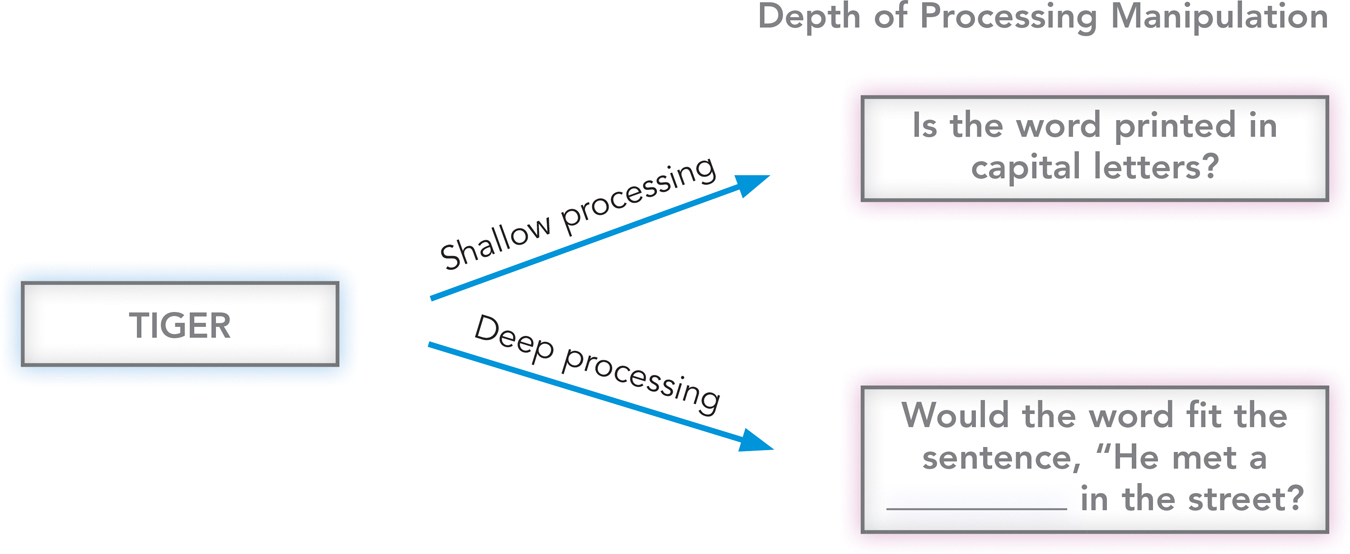
If you have used flashcards to study for tests, have you found that they promote deep processing?
THIS JUST IN
Sources of Information and Short-Term Memory
People obtain information from different sources. Sometimes we hear information (e.g., when someone tells us something), sometimes we see it (e.g., when reading a book), and sometimes we rely on touch (e.g., to find out whether water from a shower is warm). Does the information source—
Traditional theories of short-
Researchers conducted a study that, in some respects, was similar to traditional research on short-
Auditory: Participants heard tones presented for 1 second each.
Visual: Participants saw geometric figures presented for 1 second each.
Tactile: Participants felt a metal bar that vibrated for 1 second.
After retention intervals that varied from 1 to 32 seconds, another stimulus was presented (another tone, figure, or vibration), and participants had to judge whether it was the same as the previous one. The accuracy of their judgments was the measure of the retention of information in short-
225
As it turns out, they were not. As you can see in Figure 6.6, people’s memory for auditory information was substantially less good than their memory for visual or tactile information. People displayed what the researchers called an “Achilles ear”: weaker short-

The findings have significant implications for theoretical models of memory. They suggest that, rather than there being one short-
WHAT DO YOU KNOW?…
Question 4
True or False?
According to Figure 6.6, people were better at retaining auditory information in short-
FROM “SHORT-
There are two sets of letters below. Cover up one, look at the other for 30 seconds, then look away from the page and try to remember it. Then do the same thing with the other set of letters.
TGVCDPB
XYRWHKQ
Which set of letters was easier to remember? Based on what you’ve learned about short-
term memory so far, they should be equally easy or hard, because they contain the same number of letters. But most people find that they differ. The first series, in which all the letters sound similar, is harder to remember than the second, whose letters sound different (Baddeley, 2003). Why should the sound of the letters make a difference? You’ve learned about different strategies people can use to remember information: exerting attentional effort, rehearsing, processing information deeply. The existence of these different strategies raises a question not answered by the original three-
stage memory model (Atkinson & Shiffrin, 1968; Figure 6.1): What system of mind is involved in selecting and executing strategies for task performance? In the original three- stage model, short- term memory was merely a “container” for holding information, not a system that selected among task strategies.
To answer these questions, psychologists expanded the original conception of short-
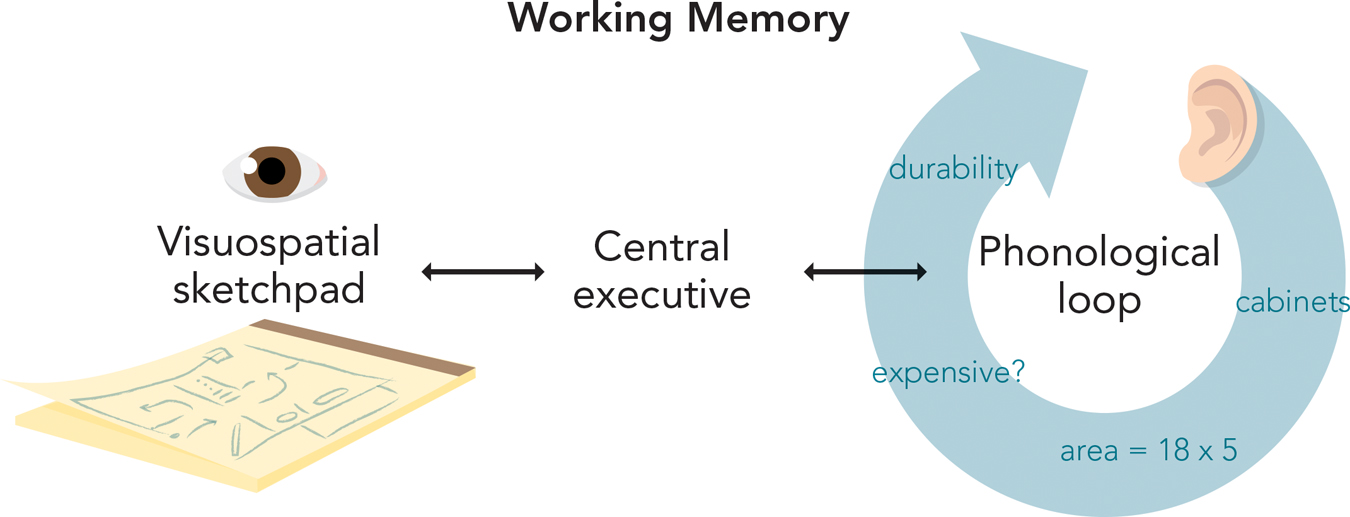
The phonological loop is a limited-
capacity memory system that encodes information according to its sound. It is active when you are “talking to yourself,” whether the talk involves an inner conversation (“I wonder what I should do for fun tonight?”) or solving an arithmetic problem (e.g., 14 × 3 = 42, then dividing 42 by the square root of 36, which is 6, and concluding the answer is 7; Lee & Kang, 2002). Because it deals with sounds, the phonological loop may have difficulties working with different pieces of information that sound similar. Recall that TGVCDPB was harder to remember than XYRWHKQ; the similar sounds in TGVCDPB created phonological loop interference. 226
The visuospatial sketchpad is a limited-
capacity memory system that processes visual images. The sketchpad enables people to create and manipulate images in their mind, as occurs when an artist or architect is at work. As its name suggests, the visuospatial sketchpad processes (1) visual information (e.g., memory for the appearance of objects you have recently seen around you) and (2) spatial information (memory of the location of the objects and their movement in the environment; Baddeley, 2003). The central executive is a mental “workspace” with “the capacity … to manipulate and create new representations” (Baddeley, 2003, p. 836). It is not a passive container for holding information, but an active system that focuses attention on tasks and can switch attention from one task to another. Information from both the visuospatial sketchpad and the phonological loop reaches the central executive, which thus can make decisions based on a wide range of information. The central executive can also work at different speeds. Sometimes it is slow and deliberate; for example, you might concentrate for long periods on a difficult math problem. But sometimes it acts quickly and automatically, with little conscious deliberation. For example, when driving, your mind responds so automatically to traffic that, after you’ve arrived at your destination, you may hardly remember the experience of driving the car.
What’s the most complex type of math problem you can solve using your working memory before you have to break out a pencil and paper or calculator?
CONNECTING TO THE BRAIN AND TO SELF-CONTROL
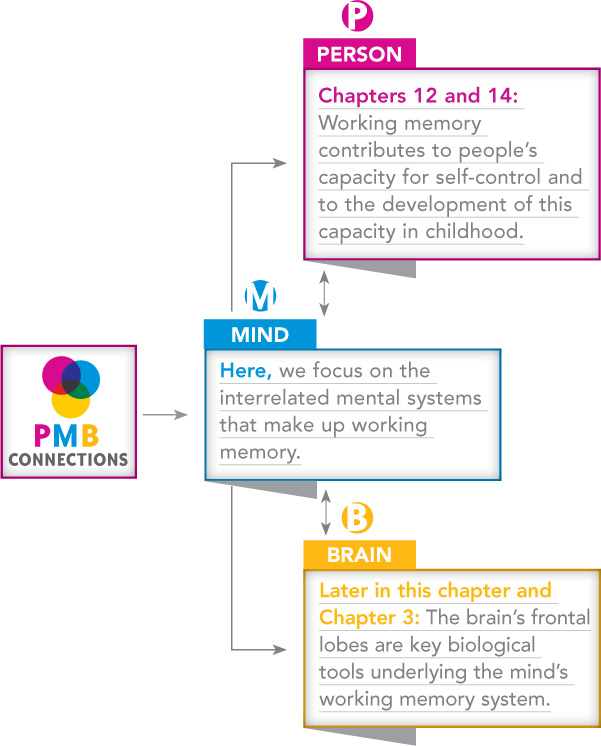
Like the phonological loop and visuospatial sketchpad, the central executive’s capacity is limited. In practice, this means that your ability to concentrate can be frustratingly small. Even if you have to finish this chapter right now to prepare for an upcoming exam, you may find your mind “wandering” (Feng, D’Mello, & Graesser, 2013); you become distracted rather than focusing on your reading. People’s ability to control their thoughts, emotions, and behavior relies on working-
When working on complex tasks, people combine information from different systems into one mental workspace. An architect, for example, might design a structure using her visuospatial sketchpad but simultaneously evaluate it and consider alternatives using her phonological loop (thinking, “It might be better if we knock out this wall”). A person can make decisions, then, based on a combination of visuospatial and verbal information.
227
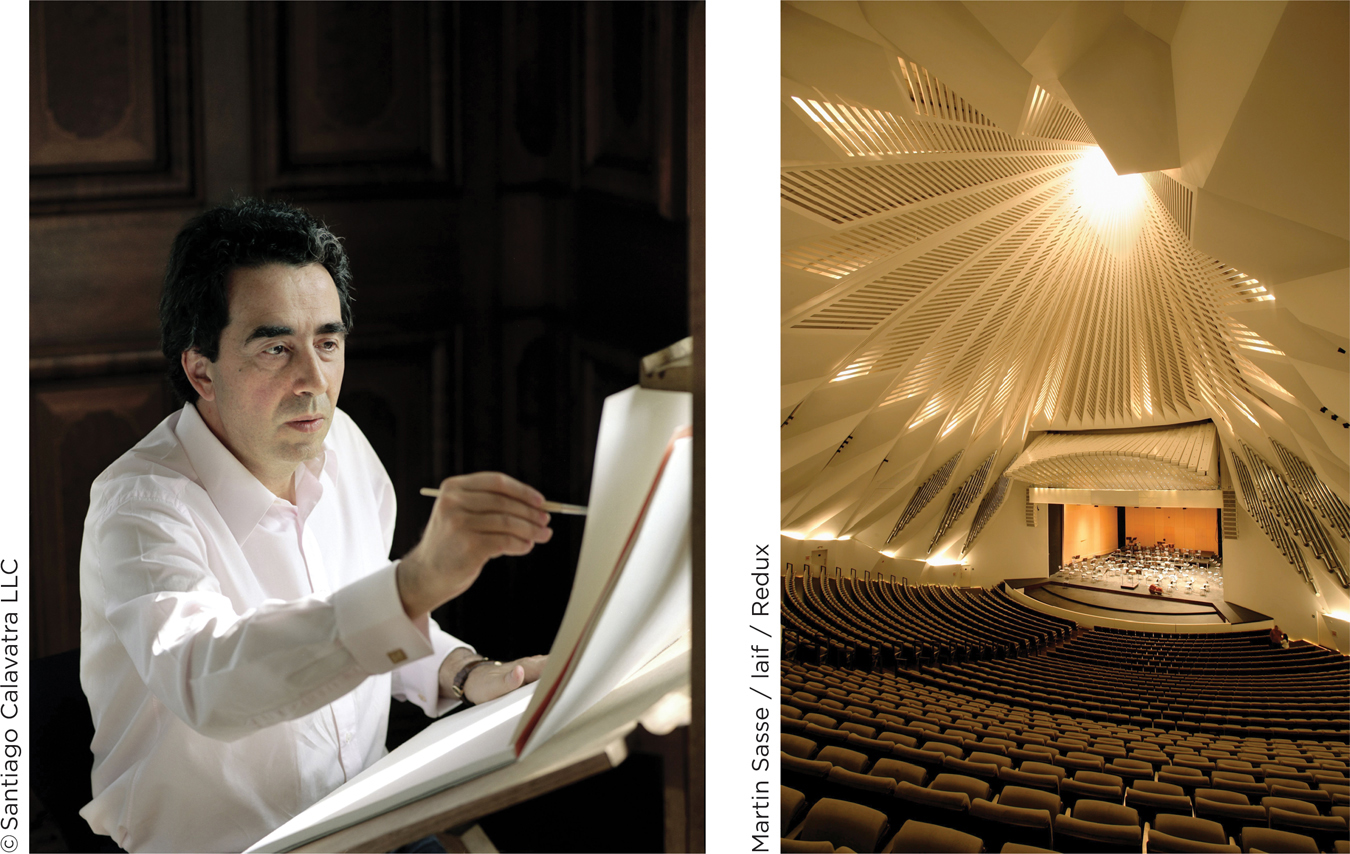
WHAT DO YOU KNOW?…
Question 5
True or False?
- GvJwYvjdYhfN1PXMIaffkLYePZTBgmbwH1p0M51FkGLIr4nMHTBmOUHMStvKQNh5
Some information takes quite a bit of attentional effort to encode, whereas information that has evolutionary significance (e.g., a fire) grabs our attention automatically.
- GXwmUalc+MmVEV01vc/nmD5XGu4PQotjGhjkLA6cIwpBO+8Tu3bXY3+/eMC4DJ9l
Miller’s estimate of the capacity of short-
term memory, seven plus or minus two, may be an underestimate, and 11 pieces of information may be more accurate. - GvJwYvjdYhfN1PXMIaffkLYePZTBgmbwH1p0M51FkGLIr4nMHTBmOUHMStvKQNh5
When research participants are presented with information to be remembered over several trials, information from the first few trials is less likely to decay than information presented later.
- GXwmUalc+MmVEV01vc/nmD5XGu4PQotjGhjkLA6cIwpBO+8Tu3bXY3+/eMC4DJ9l
When research participants are presented with information to be remembered over several trials, the later-
learned material may be lost due to retroactive interference. - GXwmUalc+MmVEV01vc/nmD5XGu4PQotjGhjkLA6cIwpBO+8Tu3bXY3+/eMC4DJ9l
Of shallow or deep processing, rote memorization would be considered deep processing.
- GvJwYvjdYhfN1PXMIaffkLYePZTBgmbwH1p0M51FkGLIr4nMHTBmOUHMStvKQNh5
According to the concept of working memory, we actively process information with the help of a phonological loop, a visuospatial sketchpad, and a central executive.
Long-Term Memory
Preview Questions
Question
 What is long-
What is long-
Question
 Once information enters long term-
Once information enters long term-
Question
 What two factors enable us to retrieve information from long-
What two factors enable us to retrieve information from long-
So far, you’ve seen how information travels from sensory memory to short-
228

LONG-
Think back to your childhood: a favorite teacher; a day when you got a great present; a “bad day” when you did something embarrassing. It’s not hard to remember them, despite the passage of time. Memories of some experiences last a lifetime.
Another type of memory that lasts is memory for how to do things. Even if you haven’t ridden a bike for years, you can hop on now and pedal away. If you hadn’t read anything for years, you would still be able to read material instantly if somebody put a book in front of you. Similarly, memories for many facts do not fade away. You won’t forget the name of the first U.S. president or the number of sides of a triangle. They are stored in your memory, permanently.
Long-
A second question concerns long-
No, you won’t—
How can long-
A third question about long-
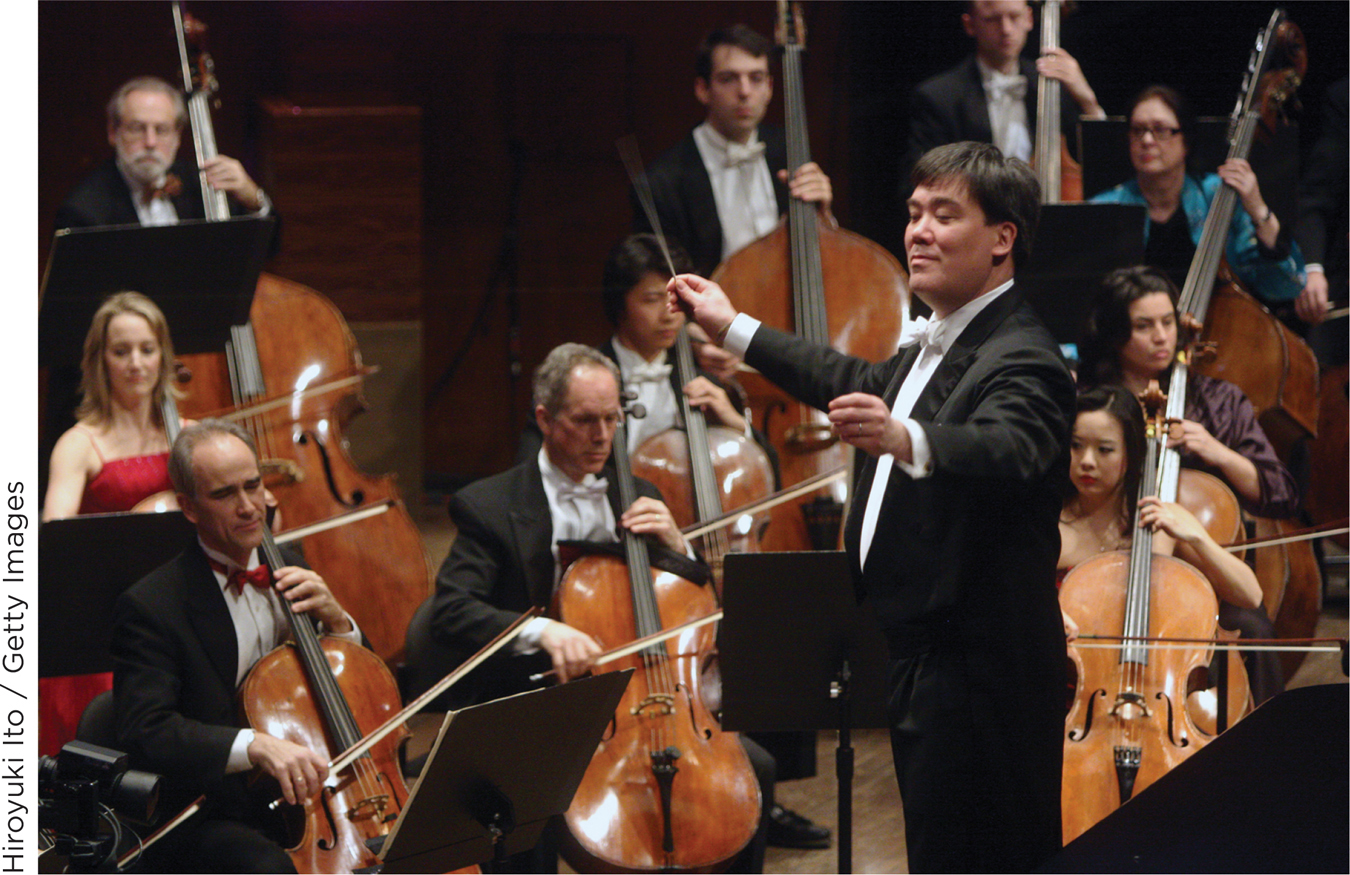
Semantic memory is memory for factual information. This information includes abstract concepts (e.g., a dog is a mammal) and concrete factual information (e.g., the capital of Kansas is Topeka). You might not be able to recall the time or place where you learned a given fact (e.g., where you learned that Topeka is the capital of Kansas), yet you still retain the factual information in semantic memory.
229
Episodic memory is memory for events that you have experienced. Autobiographical memories—
of your first date, high school graduation, or the birth of a younger sibling— are all examples of episodic memory. Episodic memory differs from semantic memory in two ways. First, you have a memory for being there: a firsthand experience of the event, including its sights, sounds, and smells. Second, episodic memory has a temporal sequence to it. Things happen one after another, and remembering one event sometimes triggers memories of what happened next. AJ, whom you read about in the chapter opening, had exceptional memory of this type. Procedural memory is memory of how to do things, such as ride a bike, drive a car, tie your shoes, and use a fork and knife. Before taking this psychology course, you may not have thought of these types of activities as aspects of “memory.” Yet they are; they are cases in which you are able to do something at one point in time because you have acquired and retained knowledge from earlier experiences. An interesting aspect of procedural memory is that you often remember how to do something (the procedural memory) without recalling either the experience of learning it (episodic memory) or the factual description of how to do it (semantic memory). For instance, if you’re like most people, you know how to tie your shoes, but you don’t remember the childhood experience in which you first learned how and can’t describe the exact steps of shoe-
tying. Tying your shoes is a procedural memory, not an episodic or semantic memory.

This shoe-
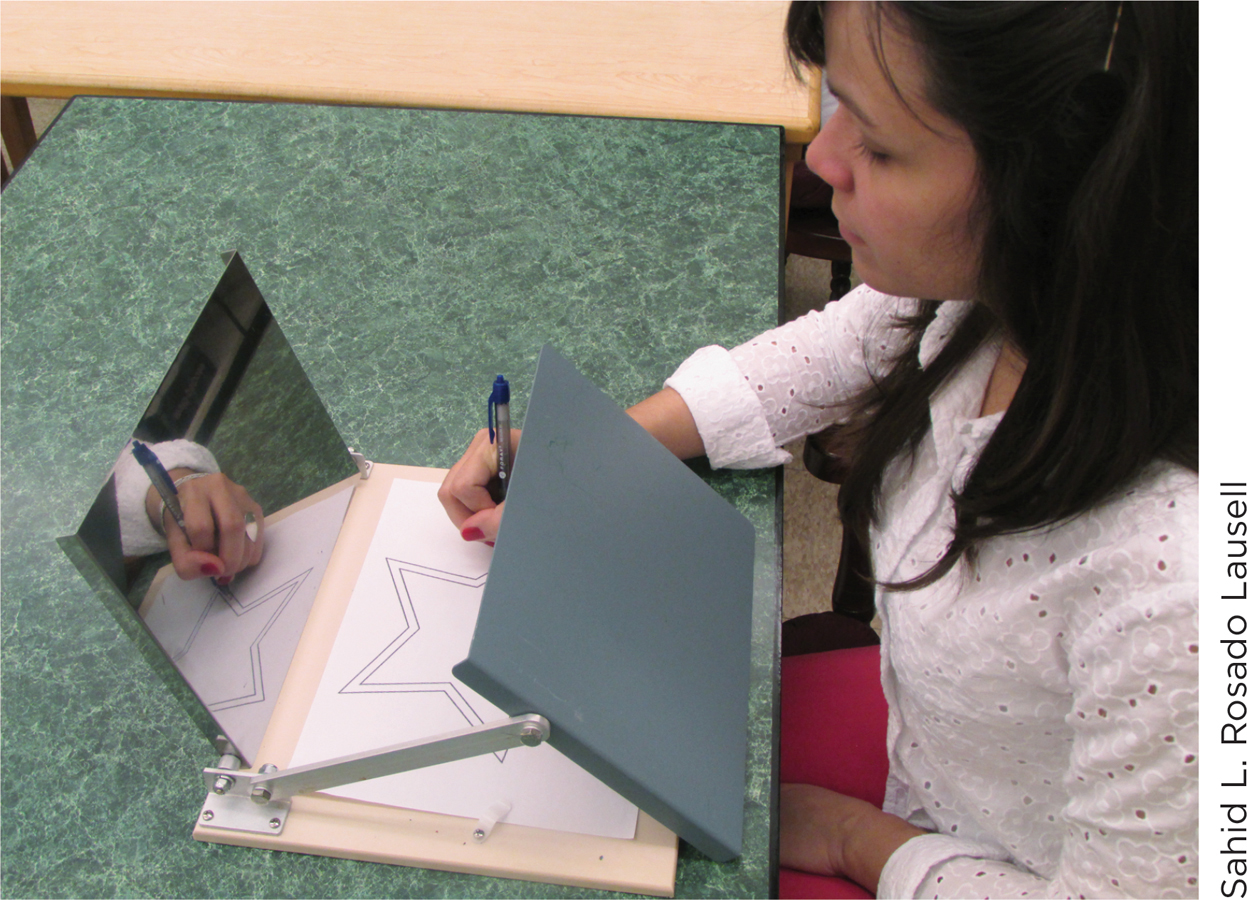
Have you ever tried to explain to someone how to ride a bike? Tough, right? What are some other implicit memories that are difficult to make explicit?
The different types of memory are distinct, yet they influence one another. Consider semantic and episodic memory. Evidence at both mind and brain levels of analysis supports the distinction between them. Research, however, also shows that if you have more of one type of memory, you are likely to acquire more of the other (Greenberg & Verfaellie, 2010). Increased semantic memory, for example, can enhance episodic memory. If you read a book about a travel location, you will acquire semantic knowledge. If you then visit the location, the increased semantic memory will tend to increase the detail and richness of the episodic memories you form.
GETTING INFORMATION INTO LONG-
230
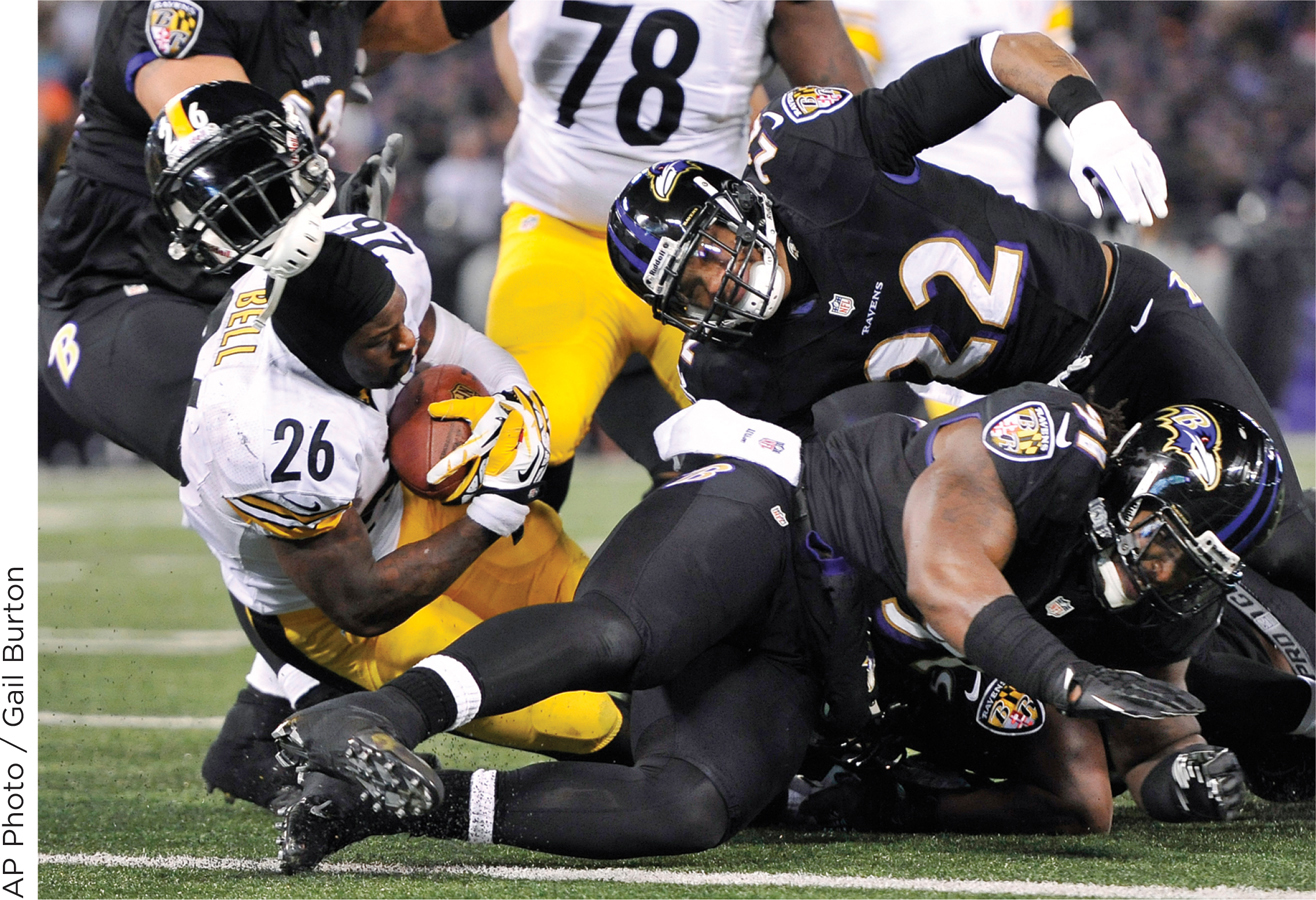
In a computer, permanent storage takes only a fraction of a second: the time needed to save information onto a hard drive. But in the mind, it can take hours or days. Information in long-
Cases of head trauma—
Consolidation processes occur not only when people acquire a new memory, but also when they are reminded of an old one. Reminders trigger a period of reconsolidation during which memories are once again temporarily fragile and unstable, as they were when being consolidated originally (Lee, 2009). During the reconsolidation period, the unstable long-
Repeated presentation of the geometric figure with no shock
A reconsolidation period triggered by reminding participants about the geometric figure, and then repeated presentation of the figure with no shock
On Day 3, the researchers presented the geometric figure again and measured participants’ reactions. In the first experimental condition, participants reacted fearfully; their reactions showed that they remembered that the geometric figure had been paired with shock. In the second condition, participants did not react at all; their reactions suggested that they had completely forgotten the connection between the figure and shock, even though information about the connection previously existed in long-
The findings illustrate that activating a memory is not like opening a book on a shelf, where the information in the book remains unchanged. Instead, during a reconsolidation period, activating a memory is more like opening a word-
RETRIEVING INFORMATION FROM LONG-
Two factors can help you retrieve information from long-
231
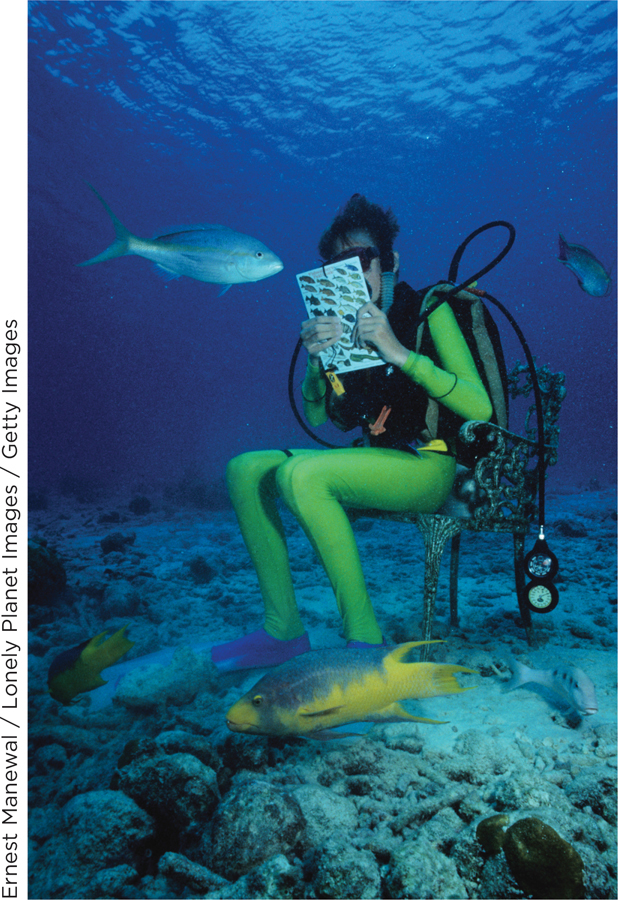
The second factor is context, that is, the overall situation or environment you are in when learning information and then trying to recall it. If the contexts at the time of learning and recall match, memory is better. A study of deep-
You may think of the word “context” as referring to external conditions, such as a classroom or coffee shop. However, people’s emotional states also are contexts that affect memory. People’s memory is better when their emotional state at recall matches their emotional state at the time they encoded the information. Gordon Bower (1981) put research participants into either a happy or sad mood and then gave them some information to learn. Later, he again induced a happy or sad mood and asked them to recall the information. Bower’s experimental design thus included four conditions: learn when happy/recall when sad; learn when happy/recall when happy; learn when sad/recall when sad; learn when sad/recall when happy. The participants’ memory was best when the recall context matched the learning context (Figure 6.8), that is, in the learn-
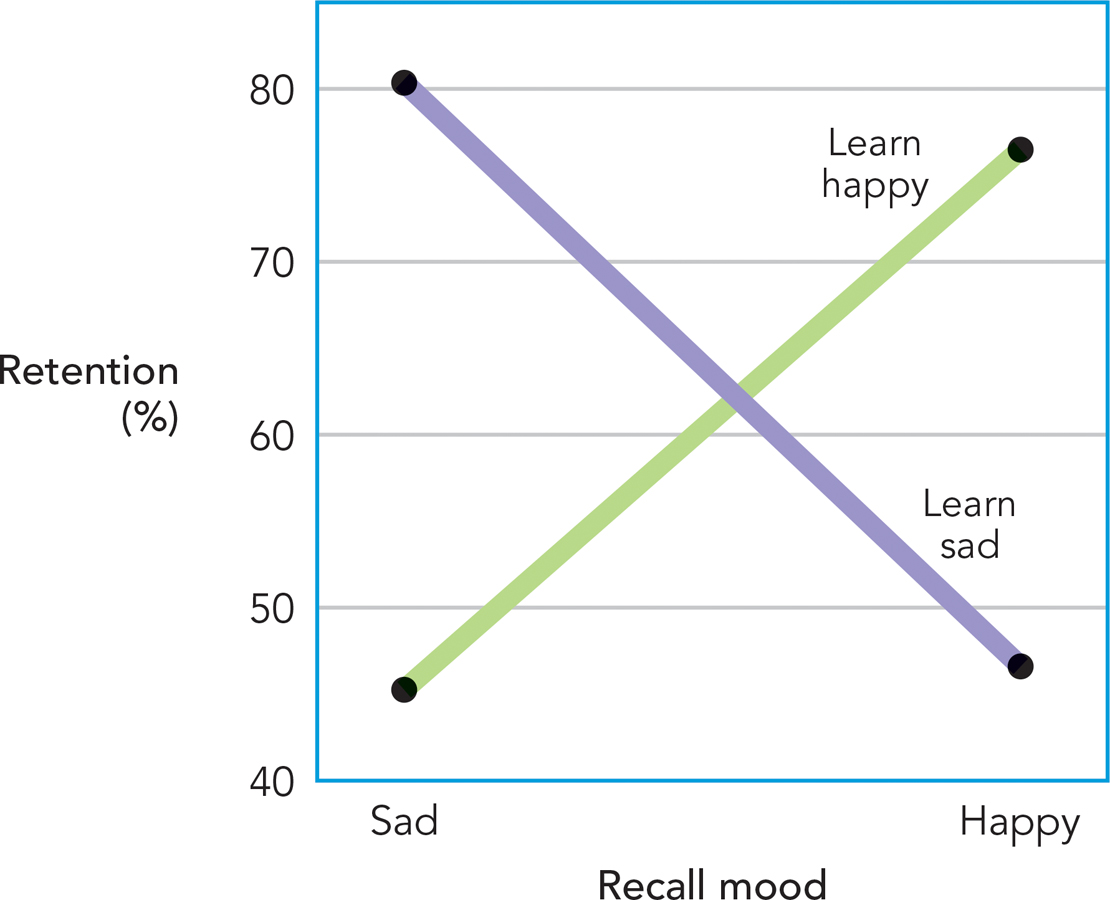
In summary, retrieval cues and context help you retrieve information from long-
WHAT DO YOU KNOW?…
Question 6
Some theorists suggest it’s more useful to think of memory as an activity, rather than as something we pnD8bJlRk8f4UjOv in containers. Knowing that long-
232